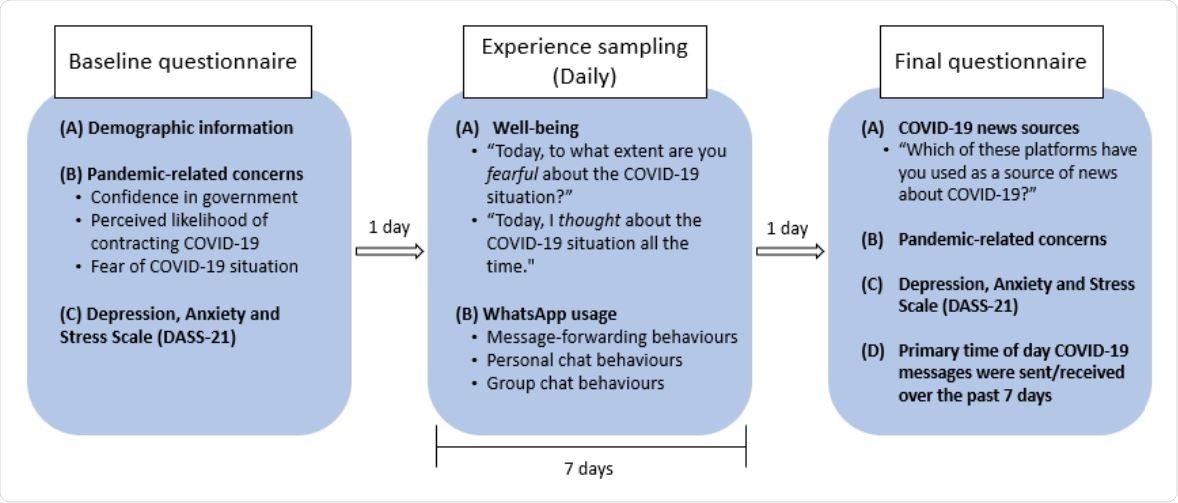A team of scientists from Singapore has recently studied the pattern of coronavirus disease 2019 (COVID-19) related WhatsApp usage in a group of people. The study reveals that almost all participants use WhatsApp for receiving or sending COVID-related content. Participants who are more actively involved in reading COVID-related content are more likely to think about the pandemic throughout the day. The study by researchers at Yale-NUS College and the National University of Singapore is currently available on the medRxiv* preprint server.
To reduce the spread of misleading information related to the COVID-19 pandemic, the social messaging platform WhatsApp has revised its rules and regulation about message forwarding in April 2020. According to a new rule, an individual can forward a content only to one recipient if the content has already been forwarded by five users previously.
Studies have shown that the tendency of people to look for or share information sharply increases during crisis periods, such as terrorist attacks, natural disasters, and epidemic situations. To gather maximum information, people generally look for various sources, especially social media platforms. However, such a rapid exchange of information can significantly increase the chance of creating misleading circumstances, which can have harmful consequences.
Current study design
The scientists aimed at deciphering the daily WhatsApp usage pattern of 151 participants during the COVID-19 pandemic. The study was conducted for one week, during which participants were contacted daily to collect information about the frequency of receiving, sharing, and discussing the pandemic-related content on WhatsApp. Also, the scientists categorized the participants based on their pandemic-related behavioral patterns on WhatsApp. Interestingly, they also investigated whether the pattern of WhatsApp usage can affect the wellbeing of an individual during the COVID-19 crisis period.
Initially, the participants were characterized via a baseline questionnaire, which collected information about participants’ demographics, concerns about the COVID-19 pandemic, and emotional state (anxiety, fear). Next, an experience sampling method was applied to record the WhatsApp usage pattern and assess the wellbeing of participants. Finally, the participants were asked about the sources from which they collect pandemic-related information and the primary time of day they mostly utilize to read and share pandemic-related information.

Schematic of study procedures. All participants completed a baseline questionnaire, followed by 7 days of experience sampling where participants addressed questions about wellbeing and WhatsApp usage daily. Participants completed a final questionnaire one day after the experience sampling protocol ended.
Important observations
The study revealed that WhatsApp is the second most common source of COVID-19 related information. About 95% of participants reported using WhatsApp at least once for COVID-19 related information. Specifically, about 52%, 78%, and 66% of participants reported sending, receiving, and discussing at least one COVID-19 related information during the study period, respectively. About 88% of participants reported that they are present in WhatsApp groups, where the exchange of pandemic information takes place.

Sources of COVID-19 news. In a questionnaire, participants self-reported where they received COVID-19 news from.
Regarding characteristic WhatsApp usage behaviors, about 14% of the participants were categorized as chronic WhatsApp users who are highly involved in receiving, sending, and discussing COVID-19 contents on the platform. Similarly, about 24% of participants were categorized as minimal users who have low counts of WhatsApp usage. In addition, 31% of participants were found to be the recipients of forwarded messages, who were also actively involved in group conversations; whereas, 30% of participants were found to be mostly involved in personal and group conversations.
Regarding COVID-19 related concern and emotional distress levels, the study revealed that chronic users are either extremely anxious about the pandemic or moderately anxious and having lower confidence in the government’s strategies. Similarly, discursive participants (participants highly involved in conversations) were found to be either extremely anxious or moderately anxious but having high faith in the government’s plans. The rest of the participants showed moderate levels of COVID-19 related fears.
Regarding personal wellbeing, the study revealed that participants who are actively involved in reading COVID-19 related information in their personal chats are more likely to think about the pandemic throughout the day. This type of behavior is known to be associated with clinical depression. Therefore, prolonged thinking about COVID-19 can negatively impact the wellbeing of an individual. Participants who mostly receive forwarded messages are particularly vulnerable to be affected by misleading information, as forward messages are more likely to contain misinformation than user-generated messages.
Overall, the study findings provide a baseline understanding of how WhatsApp usage pattern can impact a person’s viewpoint on crisis situations like the COVID-19 pandemic. The findings have implications for crisis management strategies.

 This news article was a review of a preliminary scientific report that had not undergone peer-review at the time of publication. Since its initial publication, the scientific report has now been peer reviewed and accepted for publication in a Scientific Journal. Links to the preliminary and peer-reviewed reports are available in the Sources section at the bottom of this article. View Sources
This news article was a review of a preliminary scientific report that had not undergone peer-review at the time of publication. Since its initial publication, the scientific report has now been peer reviewed and accepted for publication in a Scientific Journal. Links to the preliminary and peer-reviewed reports are available in the Sources section at the bottom of this article. View Sources
Source:
Journal references:
- Preliminary scientific report.
medRxiv preprint server. 2020. Tan EY. Tracking WhatsApp behaviors during a crisis: A longitudinal observation of messaging activities during the COVID-19 pandemic. https://www.medrxiv.org/content/10.1101/2020.09.29.20203646v1
- Peer reviewed and published scientific report.
Tan, Edina YQ, Russell RE Wee, Young Ern Saw, Kylie JQ Heng, Joseph WE Chin, Eddie MW Tong, and Jean CJ Liu. 2021. “Tracking Private WhatsApp Discourse about COVID-19 in Singapore: Longitudinal Infodemiology Study.” Journal of Medical Internet Research 23 (12): e34218. https://doi.org/10.2196/34218. https://www.jmir.org/2021/12/e34218.